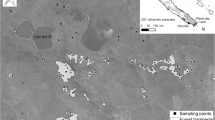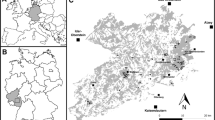Abstract
The biodiversity value of human-modified landscapes has become a central question in the tropical forest conservation biology, yet the degree to which plant populations and communities are restructured in response to environmental change remains unclear. Here, we address tree species density in a fragmented Atlantic forest landscape to test the hypothesis that tree assemblages inhabiting edge-dominated forest habitats approach typical conditions of early successional systems. Seedlings and adults from 141 tree species were sampled across 39 0.1-ha plots: 19 in small fragments (<100 ha) and 20 in mature forest stands within the interior of the largest forest remnant of the study landscape (3500 ha). A total of 5448 seedlings and adults were recorded, with >55 % of all tree species exhibiting higher densities in small fragments than in mature forest, particularly pioneers (>60 % of all species). Seedlings and adults of these proliferating species differed from species exhibiting population declines in terms of wood density and seed size, respectively. Additionally, pioneers were more abundant than shade-tolerant species, as were hardwood species in the case of seedlings. Tree species showing highest population increases consisted largely of long-lived, light-demanding canopy species bearing soft or hardwood and small-to-medium-sized seeds. Tree assemblage structure also differed in terms of forest habitats with small forest fragments supporting few rare species, whereas the most rapidly proliferating species were much more widespread and abundant in fragments. However, 60 % of all adult pioneer species recorded in small fragments were not recorded as seedlings in this habitat type, although both seedling and adult assemblages were dominated by pioneer species. Edge-dominated tree assemblages are likely to experience long-term shifts toward greater dominance of long-lived, pioneer canopy species.






Similar content being viewed by others
References
Arroyo-Rodriguez V, Pineda E, Escobar F, Benitez-Malvido J (2009) Value of small patches in the conservation of plant-species diversity in highly fragmented rainforest. Conserv Biol 23:729–739
Arroyo-Rodriguez V, Cavender-Bares J, Escobar F, Melo FPL, Tabarelli M, Santos BA (2012) Maintenance of tree phylogenetic diversity in a highly fragmented rain forest. J Ecol 100:702–711
Avissar R, Werth D (2005) Global hydroclimatological teleconnections resulting from tropical deforestation. J Hydrometeorol 6:134–145
Benchimol M, Peres CA (2015) Edge-mediated compositional and functional decay of tree assemblages in Amazonian forest islands after 26 years of isolation. J Ecol 103:408–420
Cramer JM, Mesquita RCG, Williamson GB (2007) Forest fragmentation differentially affects seed dispersal of large and small-seeded tropical trees. Biol Conserv 137:415–423
Enquist BJ, West GB, Charnov EL, Brown JH (1999) Allometric scaling of production and life-history variation in vascular plants. Nature 401:907–911
FAO (2010) Global forest resources assessment 2010. Food and Agriculture Organization of the United Nations, Rome
FAO (2011) State of the world’s forests 2011. Food and Agriculture Organization of the United Nations, Rome
Girão LC, Lopes AV, Tabarelli M, Bruna EM (2007) Changes in tree reproductive traits reduce functional diversity in a fragmented Atlantic forest landscape. PLoS One 2:e908
Grillo AS, Oliveira MA, Tabarelli M (2005) Árvores. In: Pôrto K, Almeida-Cortez JS, Tabarelli M (eds) Diversidade biológica e conservação da floresta Atlântica ao norte do rio São Francisco. Ministério do Meio Ambiente, Brasília, pp 191–216
Hartshorn GS (1978) Treefalls and tropical forest dynamics. In: Tomlinson PB, Zimmermann MH (eds) Tropical trees as living systems. Cambridge University, New York, pp 617–638
Hernandez-Ruedas MA, Arroyo-Rodriguez V, Meave JA, Martinez-Ramos M, Ibarra-Manriquez G, Martinez E, Jamangape G, Melo FPL, Santos BA (2014) Conserving tropical tree diversity and forest structure: the value of small rainforest patches in moderately-managed landscapes. PLoS One 9(6):e98931
Joly CA, Metzger JP, Tabarelli M (2014) Experiences from the Brazilian Atlantic forest: ecological findings and conservation initiatives. New Phytol 204:459–473
Laurance WF (2005) When bigger is better: the need for Amazonian mega-reserves. Trends Ecol Evol 20:645–648
Laurance WF, Delamonica P, Laurance SG, Vasconcelos HL, Lovejoy TE (2000) Conservation: rainforest fragmentation kills big trees. Nature 404:836
Laurance WF, Nascimento HEM, Laurance SG, Andrade A, Ribeiro JEL, Giraldo JP, Lovejoy TE, Condit R, Chave J, Harms KE, D’Angelo SA (2006a) Rapid decay of tree-community composition in Amazonian forest fragments. Proc Natl Acad Sci-USA 103:19010–19014
Laurance WF, Nascimento HEM, Laurance SG, Andrade AC, Fearnside PM, Ribeiro JEL, Capretz RL (2006b) Rain forest fragmentation and the proliferation of successional trees. Ecology 87:469–482
Laurance WF, Sayer J, Cassman KG (2014) Agricultural expansion and its impacts on tropical nature. Trends Ecol Evol 29:107–116
Lôbo D, Leão T, Melo FPL, Santos AMM, Tabarelli M (2011) Forest fragmentation drives Atlantic forest of northeastern Brazil to biotic homogenization. Divers Distrib 17:287–296
Lopes AV, Girao LC, Santos BA, Peres CA, Tabarelli M (2009) Long-term erosion of tree reproductive trait diversity in edge-dominated Atlantic forest fragments. Biol Conserv 142:1154–1165
Lorenzi H (1992) Árvores brasileiras. Plantarum, Nova Odessa
Magurran AE (1988) Ecological diversity and its measurement. Cambridge University, Cambridge
Melo FPL, Dirzo R, Tabarelli M (2006) Biased seed rain in forest edges: evidence from the Brazilian Atlantic forest. Biol Conserv 132:50–60
Melo FPL, Martinez-Salas E, Benitez-Malvido J, Ceballos G (2010) Forest fragmentation reduces recruitment of large-seeded tree species in a semi-deciduous tropical forest of southern Mexico. J Trop Ecol 26:35–43
Melo FPL, Arroyo-Rodriguez V, Fahrig L, Martinez-Ramos M, Tabarelli M (2013) On the hope for biodiversity-friendly tropical landscapes. Trends Ecol Evol 28:462–468
Michalski F, Nishi I, Peres CA (2007) Disturbance-mediated drift in tree functional groups in Amazonian Forest fragments. Biotropica 39:691–701
Oliveira MA (2007) Fragmentação e riqueza de árvores em escala local e regional na floresta Atlântica nordestina: implicações para a conservação. Universidade Federal de Pernambuco, Recife
Oliveira MA, Grillo AS, Tabarelli M (2004) Forest edge in the Brazilian Atlantic forest: drastic changes in tree species assemblages. Oryx 38:389–394
Oliveira MA, Santos AMM, Tabarelli M (2008) Profound impoverishment of the large-tree stand in a hyper-fragmented landscape of the Atlantic forest. For Ecol Manage 256:1910–1917
Paula MD, Alves-Costa CP, Tabarelli M (2011) Carbon storage in a fragmented landscape of Atlantic forest: the role played by edge-affected habitats and emergent trees. Trop Conserv Sci 4:349–358
Peres CA (2005) Why we need megareserves in Amazonia. Conserv Biol 19:728–733
Peres CA, Palacios E (2007) Basin-wide effects of game harvest on vertebrate population densities in Amazonian forests: implications for animal-mediated seed dispersal. Biotropica 39:304–315
Pütz S, Groeneveld J, Alves LF, Metzger JP, Huth A (2011) Fragmentation drives tropical forest fragments to early successional states: a modelling study for Brazilian Atlantic forests. Ecol Model 222:1986–1997
R Core Team (2015) R: a language and environment for statistical computing. R Foundation for Statistical Computing, Vienna. http://www.R-project.org/
Ribeiro MC, Metzger JP, Martensen AC, Ponzoni FJ, Hirota MM (2009) The Brazilian Atlantic forest: how much is left, and how is the remaining forest distributed? implications for conservation. Biol Conserv 142:1141–1153
Sala OE, Chapin FS, Armesto JJ, Berlow E, Bloomfield J, Dirzo R, Huber-Sanwald E, Huenneke LF, Jackson RB, Kinzig A, Leemans R, Lodge DM, Mooney HA, Oesterheld M, Poff NL, Sykes MT, Walker BH, Walker M, Wall DH (2000) Biodiversity—global biodiversity scenarios for the year 2100. Science 287:1770–1774
Santos BA, Peres CA, Oliveira MA, Grillo A, Alves-Costa CP, Tabarelli M (2008) Drastic erosion in functional attributes of tree assemblages in Atlantic forest fragments of northeastern Brazil. Biol Conserv 141:249–260
Santos BA, Arroyo-Rodriguez V, Moreno CE, Tabarelli M (2010) Edge-related loss of tree phylogenetic diversity in the severely fragmented Brazilian Atlantic forest. PLos One 5:e12625
Santo-Silva EE, Almeida WR, Melo FPL, Zickel CS, Tabarelli M (2013) The nature of seedling assemblages in a fragmented tropical landscape: implications for forest regeneration. Biotropica 45:386–394
Silva JMC, Tabarelli M (2000) Tree species impoverishment and the future flora of the Atlantic forest of northeast Brazil. Nature 404:72–74
Tabarelli M, Peres CA (2002) Abiotic and vertebrate seed dispersal in the Brazilian Atlantic forest: implications for forest regeneration. Biol Conserv 106:165–176
Tabarelli M, Mantovani W, Peres CA (1999) Effects of habitat fragmentation on plant guild structure in the montane Atlantic forest of southeastern Brazil. Biol Conserv 91:119–127
Tabarelli M, Lopes AV, Peres CA (2008) Edge-effects drive tropical forest fragments towards an early-successional system. Biotropica 40:657–661
Tabarelli M, Aguiar AV, Girao LC, Peres CA, Lopes AV (2010a) Effects of pioneer tree species hyperabundance on forest fragments in northeastern Brazil. Conserv Biol 24:1654–1663
Tabarelli M, Aguiar AV, Ribeiro MC, Metzger JP, Peres CA (2010b) Prospects for biodiversity conservation in the Atlantic forest: lessons from aging human-modified landscapes. Biol Conserv 143:2328–2340
Tabarelli M, Peres CA, Melo FPL (2012) The ‘few winners and many losers’ paradigm revisited: emerging prospects for tropical forest biodiversity. Biol Conserv 155:136–140
van Roosmalen MGM (1985) Fruits of the Guianan flora. Institute of systematic botany, Utrecht
Veloso HP, Rangel-Filho ALR, Lima JCA (1991) Classificação da vegetação brasileira adaptada a um sistema universal. IBGE, Rio de Janeiro
Zanne AE, Lopez-Gonzalez G, Coomes DA, Jansen S, Lewis SL, Miller RB, Swenson NG, Wiemann MC, Chave J (2009) Global wood density database. http://hdl.handle.net/10255/dryad.235
Acknowledgments
We thank Alexandre Grillo (in memoriam), Marcondes Oliveira and Eleno José de Araújo (in memoriam) for plant identification and for making their adult tree database available to us. The Centro de Pesquisas Ambientais do Nordeste (CEPAN) and Usina Serra Grande provided infrastructure and logistic support. We also thank Conservation International—Brazil, Conselho Nacional de Ciência e Tecnologia (CNPq) and Coordenação de Aperfeiçoamento de Pessoal de Nível Superior (CAPES) for research grant to MT, and Fundação de Amparo a Ciência e Tecnologia de Pernambuco (FACEPE) for doctorate fellowship to EESS (process 0455-2.05/09). Finally, we thank CAPES for a doctorate “sandwich” scholarship to EESS (process 17547/12-1).
Author information
Authors and Affiliations
Corresponding author
Additional information
Communicated by Philip Ladd.
Electronic supplementary material
Below is the link to the electronic supplementary material.
Rights and permissions
About this article
Cite this article
Santo-Silva, E.E., Almeida, W.R., Tabarelli, M. et al. Habitat fragmentation and the future structure of tree assemblages in a fragmented Atlantic forest landscape. Plant Ecol 217, 1129–1140 (2016). https://doi.org/10.1007/s11258-016-0638-1
Received:
Accepted:
Published:
Issue Date:
DOI: https://doi.org/10.1007/s11258-016-0638-1




